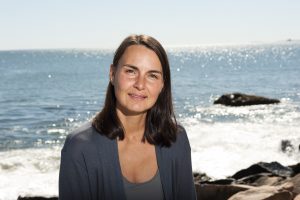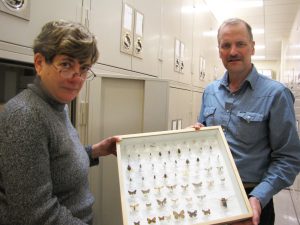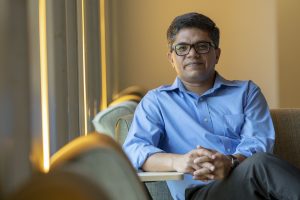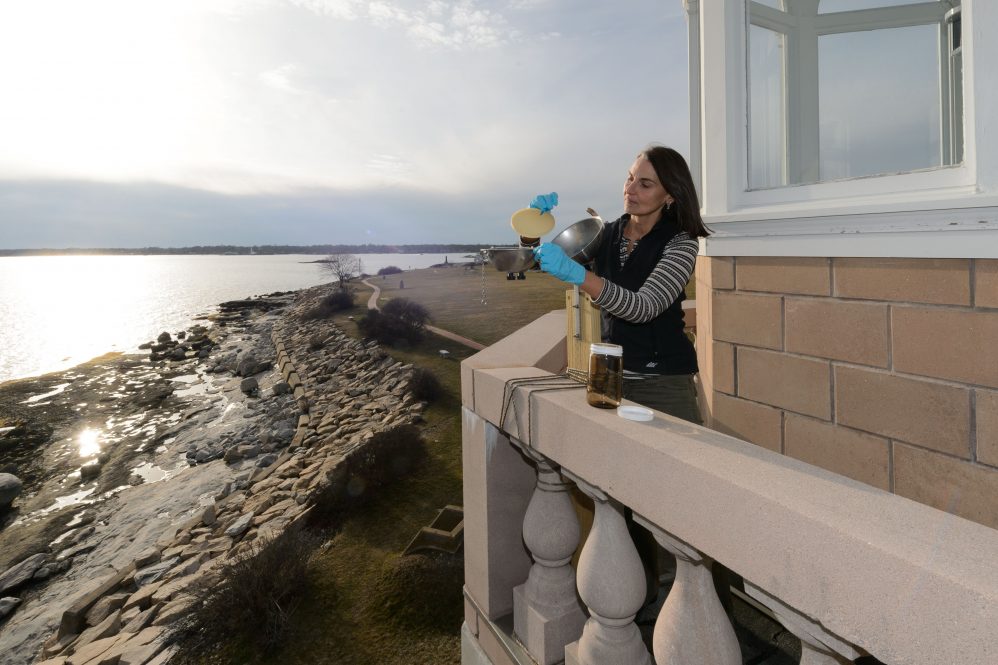About 30 years ago, the waters of the Long Island Sound were looking bleak.
Pollution from the more than nine million people living in the Sound’s watershed had reached epic heights. Nitrogen runoff led to chronic seasonal blooms of algae, which led to bacteria consuming so much oxygen that periodically, piles of dead fish turned up on beaches. Swimming was frequently banned in many areas, and the public began to notice in ways they hadn’t before.
“It was obvious that hypoxia in the Long Island Sound had been worsening and expanding,” says Penny Vlahos, associate professor of marine sciences.
Enter the Long Island Sound Study, an unprecedented partnership among Connecticut and New York state government agencies, scientists, and nonprofit groups. Formed in 1985, it began collecting data on the Sound that informed an early-90’s conservation and management plan to restore the Sound to health.
Now, Vlahos and her colleagues have put this hard work to the test, showing that the Sound has vastly improved – but with some big caveats.
Vlahos is among more than 30 professors in the College of Liberal Arts and Sciences who study the environment and its protection. From ocean chemistry to insect diversity to racism in environmentalism, the researchers’ work spans the disciplines of sciences, social sciences, and humanities.
“We need to understand not just the [environmental] changes that have happened, but the ones that are coming, so we can be prepared for them,” Vlahos says.
Recuperating the Sound
By the year 2000, the states of Connecticut and New York, informed by the Long Island Sound Study, had invested heavily in reducing wastewater treatment into the Sound. Through new regulations and investment in better monitoring, they set a goal of reducing nitrogentotal maximum daily loads (TMDLs) into the Sound by 50 percent of 2000 levels by 2020.

Vlahos and colleague Michael Whitney, associate professor of marine sciences, compared data collected from 1994 to the present and their own sampling data. In their paper published in January in Environmental Science and Technology, they showed the states have met this goal. Water quality has improved, ecosystem health has improved, and there are far fewer beach closures.
But, says Vlahos, the elephant in the room remains: climate change. Warming waters will reduce the amount of oxygen the waters can hold and reverse some of the gains accomplished. These changes can lead to more hypoxia, harmful algal blooms, and to an increased need for environmental protection measures.
“These positive changes will not last,” Vlahos says. “By the year 2100, the Sound will be warmer, and we will have to incrementally reduce nitrogen TMDLs by much more just to maintain this level of health.”
Recently, Vlahos also took part in second United Nations World Ocean Assessment, an evaluation project of the state of the world’s oceans that takes place every five years and includes hundreds of scientists globally. Vlahos served on committees examining contaminants including microplastics, an emerging health threat as degraded plastic matter accumulates in the oceans.
“Microplastics are a poorly characterized but emerging concern because they are in so many products,” says Vlahos – shampoo, for example – with no requirement to disclose their presence on the product label. The committee created a call to action to limit how microplastics are used and get into the oceans.
“Current levels in the environment are relatively low but this issue needs better method development and international collaboration to understand and keep an eye on it before it gets bad,” Vlahos concludes.
‘A Thousand Cuts’
While Vlahos works to find ways to recuperate the oceans, David Wagner, professor of ecology and evolutionary biology, is one of many ecologists raising an alarm for the insect world, which Wagner has famously labeled as undergoing “death by a thousand cuts.”

“Insects are without a doubt the most important animal biomass in the planet’s terrestrial ecosystems,” he says. “They pollinate, make soil, clean water, feed other animals … They are the fabric of life on Earth.”
Whispers and anecdotes have been circulating among bug lovers, of both the amateur and scientist variety, for about a decade. People just weren’t seeing bugs around in the numbers they’d seen 20 or 30 years ago.
Then, a 2017 German study showed a 75 percent decline in flying insects over the previous 27 years. But the scientists could not figure out why.
“It echoed the persistent feeling that many naturalists had for many years: The insects are dying,” says Wagner.
Wagner has long studied the Lepidoptera, an insect group that includes butterflies and moths, and was called upon to organize a program symposium at the Entomological Society of America’s annual meeting in 2019. The symposium resulted in a special issue of the Proceedings of the National Academy of Sciences – one of the preeminent scientific journals – devoted to the problem. The special issue is already one of the most highly cited issues in the journal’s history.
Wagner points out that, although controlled experiments to determine the specific causes of insect decline are impossible on a global scale, it likely comes down to a handful of different stressors. The issue detailed the 12 largest global threats to insects, underlined the urgency of slowing climate change and lessening the impacts of global agriculture, and offered tangible steps that everyday people could take to help save insects, from growing native plants to decreasing lawn pesticide use and exterior lighting.
Changing perspectives is an especially important step, especially in the U.S., where many people think “the only good bug is a dead bug,” says Wagner.
Wagner has been asked to organize another symposium, this time an international one, at the upcoming International Congress of Entomology in Helsinki, Finland. There, he hopes to begin in earnest the process of recommending tangible steps to change the fate of insects.
“You can’t have these kinds of losses and expect to have a future, rife in nature’s riches, to pass along to our children,” he says.
Environment and Justice
Environmental issues aren’t limited to animals and plants, notes Prakash Kashwan, associate professor of political science. In fact, he says, his recent popular press statements about the effects of environmentalism seem to have caused some anxiety.

“Saying environmentalism can be racist is a big statement to make,” he says.
But that’s what his research shows. As a political economist who works at the intersection between environmental science and societal processes, Kashwan has shown that, when they are not thought through, environmental programs can produce serious inequalities.
“Somebody’s got to bring both the scientific data and the impacts on societies into the policy process,” he says.
For example, preserving large uninterrupted areas of land for conservation might, on the surface, seem like a good idea. But some lands are more susceptible to wildfires when not managed by humans, and Kashwan says small-scale farming can have benefits to both the environment and societies.
“These sweeping programs often end up with bad side effects,” says Kashwan. “You can talk to climate scientists about the effects that certain climate interventions, say, solar radiation management, may have on the monsoons in large parts of Asia and East Africa, and they may speak about how to model these effects. But an estimated two billion people depend on those monsoons, so you need to be careful.”
Kashwan’s first book, “Democracy In the Woods,” examined the history of environmental policy and its intersection with social justice issues across different countries. He concluded that large societies need to have systems that integrate environmental policies into governance, not simply leaders who care about and enact environmental programs. It also illustrates examples of win-win situations for the environmental and local societies, largely from Mexico.
His upcoming book will focus specifically on climate justice in the U.S. and Canada, including the social effects of emissions reduction policies, and point out ways social justice needs to be taken into account in environmental policy.
“People talk about carbon dioxide removal from the atmosphere [to reduce the greenhouse effect],” Kashwan says. “But then, where do you put that carbon? It’s a pollutant. Who gets the short end of the stick and lives next to a waste site?”
Kashwan was recently named an editor at the influential journal Environmental Politics, and his expertise has been called for in the work of the Intergovernmental Science-Policy Platform on Biodiversity and Ecosystem Services and the United Nations Economic Commission for Africa to inform international law around climate justice, biodiversity, and ecosystem services.
He is quick to point out that the quickest solutions to environmental problems are often not the best ones.
“In many cases we need something big and transformative,” he says. “But if you take the quickest solution, the path of least resistance, you may end up hurting people.”
The three researchers agree that if there is one thing individuals can do, especially on the heels of the COVID-19 pandemic, to serve the planet, it’s to get outside and appreciate nature.
“Learning about nature, understanding what’s growing in your yard – that’s the best way to start acting ‘green,’” Wagner says.
This article is the second in a series about emerging research areas in UConn’s College of Liberal Arts and Sciences. Learn more at #DiscoverUConnCLAS.



